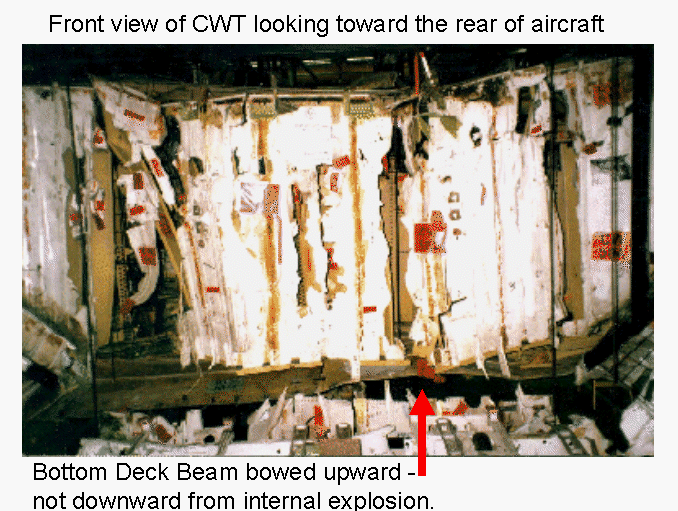The NTSB was SO concerned about this that they waited until 2008, twelve years after the TWA-800 disaster, eight years after they made their conclusion of its cause, to release their final directive on fuel tank inerting. . . and then only required retro-fitting the existing fleet by 2018! In addition, they only identified 60 out of over 1500 or so 747s among the aircraft to even be retrofitted! What's wrong with this picture, if it was such a dangerous condition and design as they claimed?
"The final rule does not direct the adoption of specific inerting technology either by manufacturers or operators, but establishes a performance-based set of requirements that set acceptable flammability exposure values in tanks most prone to explosion or require the installation of an ignition mitigation means in an affected fuel tank. Technology now provides a variety of commercially feasible methods to accomplish these vital safety objectives," according to the FAA.It said technology now exists that can prevent ignition of flammable fuel vapors by reducing their oxygen concentration below the level that will support combustion. The likelihood of an explosion when a fire source is introduced to the fuel tank is reduced by making the vapors 'inert'.
FAA-developed prototype onboard fuel tank inerting systems have been successfully flight tested on Airbus A320 and Boeing 747 and 737 airplanes. The FAA has approved inerting systems for the Boeing 747 and 737, with two aircraft of each model type performing as expected during airline in-service evaluations. Boeing plans to install these systems on all new production airplanes.
Within two years, all new aircraft must include the technology designed to significantly reduce the risk of center fuel tank fires as part of the final rule. In addition, within ten years, large passenger transports built after 1992 must be retrofitted with technology designed to keep center fuel tanks from catching fire.
The cost of installing the new technology is estimated to range from $92,000 to $311,000 per aircraft, depending on its size, a far cry from the estimated $20 billion that an industry group had previously estimated for the overall cost.
The 2,730 U.S. aircraft that must be retrofitted include: 900 A-320s, 50 A-330s, 965 Boeing 737s, 60 Boeing 747s, 475 Boeing 757s, 150 Boeing 767s and 130 Boeing 777s.
Industry officials believe the safety modifications will cost an estimated $1 billion just for US-registered jetliners. Many foreign air carriers voluntarily adhere to U.S. air safety directives and further nitrogen generation system sales outside the United States can be expected.
There are at least two companies claiming to have developed nitrogen generation systems that comply with the new federal safety directive. Honeywell says it has now delivered Nitrogen Generation Systems (NGS) for the Boeing Next-Generation 737 aircraft, which delivers nitrogen-enriched air to the aircraft center fuel tank, significantly reducing flammability and increasing commercial aircraft safety."— "Industry Steps Forward On Fuel Tank Inerting", Aviation Today, August 4, 2008
It seems the NTSB was not in too much of a hurry to do anything. They did not take their TWA-800 conclusions seriously enough to release the final directive in any kind of timely fashion.
When we look at the tests they ran to justify their findings, to get the Center Wing Tank to explode at all, they had to fill it with propane. Jet A Fuel (kerosene) is hard to even light on fire, much less to get to explode. They could NOT get a Center Wing Tank to explode even with their theoretical optimal fuel/air mix which would make the ideal flash over if there were a ignition source. They finally got some results when they mixed the Jet A Fuel with pure oxygen. However, they could not, ever, demonstrate that the Jet A Fuel would mix spontaneously in the 747 Center Wing Tank from the ullage amount left in an empty tank to create anything close to the ideal fuel/air mix necessary for detonation at anything close to the temperatures they theorized existed on that July day in 1996.
Their other problem was there simply was no ignition source inside the CWT. Boeing had designed it not to have any such ignition source. . . Or any electrical at all.
When the Center Wing Tank was recovered from the ocean, it showed no sign of outwardly bowed distortions in its structure which would have to have been there had it exploded. Instead, it showed INWARDLY bowed distortions as though the pressures that damaged it came from the outside of the tank which were totally inconsistent with it exploding.

The Center Wing Tank is not just a fuel tank, it is made up of load bearing structural members, It is, in fact, constructed like a box girder and is the part of the plane to which the wings are attached to the fuselage. Had the Center Wing Tank exploded as the initiating event, the wings would not have supported the plane for any kind of zoom climb at all as the NTSB and CIA showed in the cartoons. The wings could not have handled the stress at all. Instead, the left wing detached late in the event instead of early, far after the "Zoom climbs" of either the CIA or NTSB theories of the event.